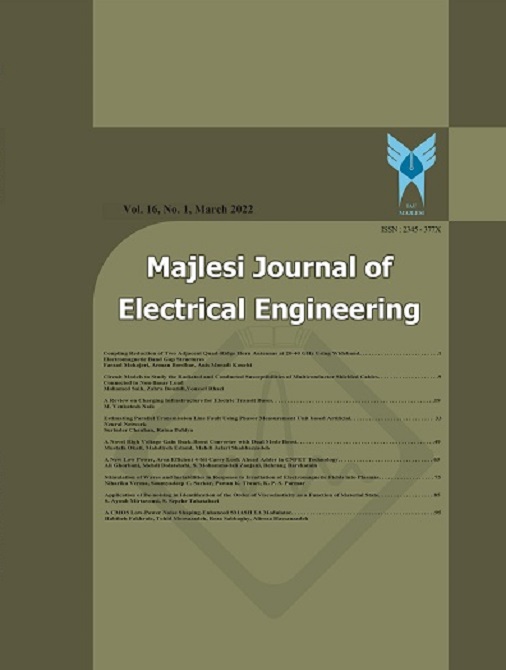[1]. RC. Sonderegger, D. Henderson, S. Bubb, J. Steury. “Distributed asset insight”, IEEE Power and Energy Magazine, Vol:3,1, pp: 32 - 39, 2004
[2]. R.C. Bansal, T.S. Bhatti, D.P. Kothari, “Bibliography on the application of induction generators in non-conventional energy systems”, IEEE Transactions on Energy Conversion, Vol. 18 3, 433–439, 2003
[3]. R.C. Bansal, “Three-phase self-excited induction generators: an over view”, IEEE Transactions on Energy Conversion, Vol.20, 2, pp:292–2999, 2005
[4]. K. Gogas, “Design of a robust speed and position sensorless decoupled p-q controlled doubly-fed induction generator for variable-speed wind energy applications”, B.Eng. Concordia University, Canada, February 2007
[5]. M. Machmoum, F. Poitiers, “Sliding mode control of a variable speed wind energy conversion system with DFIG”, International Conference and Exhibition on Ecologic Vehicles and Renewable Energies, Monaco, 2009.
[6]. T. Noguchi, H. Tomiki, S. Kondo and I. Takahashi, “Direct power control of PWM converter without power-source voltage sensors”, IEEE Trans. Ind. Appl, vol. 34, 3, pp. 473–479, May–Jun. 1998.
[7]. M. Malinowski, M. P. Kazmierkowski, S. Hansen, F. Blaabjerg and G. D. Marques, “Virtual-flux-based direct power control of three-phase PWM rectifiers”, IEEE Trans. Ind. Appl, vol. 37, 4, pp. 1019–1027, Jul.–Aug. 2001.
[8]. A. Hossain Mollah, Prof. G K Panda, Prof. P K Saha,Three Phase Grid Connected Photovoltaic System with Maximum Power Point Tracking, IJAREEIE, pages 2278 – 8875, Vol. 4, Issue 5, May 2015
[9]. Bimal K. Bose, “Power Electronics and Motor Drives Advances and Trends”, British Library Cataloguing-in-Publication Data, London, 2006, p.209–217
[10]. T. Noguchi, H. Tomiki, S. Kondo and I. Takahashi, “Direct Power Control of PWM Converter without Power- Source Voltage Sensors”, IEEE Trans. Ind. Applicat., vol. 34, 3, pp. 473-479, May/June, 1998.
[11]. Li ning, H.jingjing, Z.hui, W.yue, W.zhao’an, “A novel direct power control strategy of three-level NPC rectifier without abnormal instantaneous reactive power fluctuation”, 9th International Conference on Power Electronics-ECCE Asia, Seoul, Korea. June 1 - 5, 2015
[12]. M.V. Kazemi, M. Moradi, R.V. Kazemi, “Minimization of powers ripple of direct power controlled DFIG by fuzzy controller and improved discrete space vector modulation”, Electric Power Systems Research, Vol. 89, pp: 23– 30, 2012
[13]. A. julean,”Aactive damping of LCL filter resonance in grid connected applications”, Master Thesis, PED10-1035 - Spring Semester, 2009.
[14]. Hornik, M. Stinchcombe and H. White, “Multilayer feed forward networks are universal approximators”, Neural Networks 1989; 2: 359-366
[15]. P. Werbos, “Beyond regression: new tools for prediction and analysis in the behavioral sciences”, PhD thesis, Cambridge, MA: Harvard University Committee on Applied Mathematics, 1974.
[16]. D. Kukolj, F. Kulic and E. Levi. Design of Speed Controller for Sensorless Electric Drives based on AI Techniques: a comparative study. Artificial Intelligence in Engineering 2000; 14:165- 174
[17]. R. Kumar, R. A. Gupta, S.V. Bhangale, and H. Gothwal. “Artificial neural network based direct torque control of induction motor drives”, IETECH Journal of Electrical Analysis 2008; 2:159-165.
[18]. Cirrincione, M.C. Lu, and M. Pucci, ” Direct torque control of induction motors by use of the GMR neural network”, International Joint Conference on Neural Networks; 20-24 July 2003. Portland, Oregon, USA. pp. 2106-2111.

